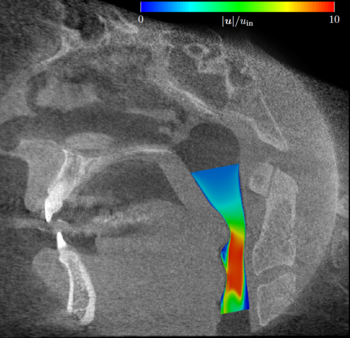Fluid Dynamics
Fluidic systems in the human body like the blood or respiration systems are hard to access for mechanical measurement apertures. But, detailed information about velocity and pressure distributions in an individual ‘s anatomy can help to identify pathophysiological situations and lead to patient-specific therapy planning.
In the area of image computing tomographic images of MR or CT can be analysed to acquire a digital representation of the patient’s individual anatomy. On the one hand, these digital models can be used for the in-silico examination of flow fields. In order to compute fluid dynamics under given constraints conservation laws of mass, momentum and energy have to be solved. These are a set of partial differential equations of second order, called the Navier-Stokes equations (NSE). The solution of the NSE is a numerical challenging task especially in complex, anthropomorphic geometries.
On the other hand, digital models can be converted to hardware models by additive manufacturing techniques. These models allow for the use of pressure sensors as well as established velocity measurement techniques like phase-contrast MRI (PC-MRI). Hence, 3D-printed models can give an insight in the patient’s individual flow situation and additionally serve as a validation tool for in-silico fluid dynamics simulations.
I-SLEEP
Currently, the research focuses on the patient individual therapy planning of obstructive sleep apnea (OSA) by mandibular advancement appliances (MAA). OSA is a sleep related breathing disorder that is characterized by a repetitive partial or complete collapse of the upper airways during sleep due to reversible soft tissue deformations. The pharyngeal lumen is temporarily widened by mandibular protrusion via MAA reducing the collapsibility of the upper airways. A trade of between the amount of widening and the protection of teeth and mandibular joint has to be found.
In the project „In-Silico-Simulation der Luftströmung im virtuellen Schlaflabor und experimentelle Evaluation patientenindividueller Protrusionsschienen für die Therapie der obstruktiven Schlafapnoe“ (I-SLEEP) an optimal patient-specific protrusion position shall be determined by computational analysis of digital pharynx models extracted from MR images. The project aims at establishing a virtual sleep laboratory instead of the inconvenient and cost-intensive examinations in conventional sleep laboratories.

In-silico simulated airstream velocity in the pharynx of a sleep apnea patient acquired from a dental cone beam CT. A velocity increase indicating a pressure drop in the retropalatal area is a hint for pharyngeal collapsibility.
Grants
- Federal Ministry of Education and Research under grant number BMBF 13GW0276B
Cooperations
- HICAT GmbH, Bonn, Germany
- Universität zu Lübeck, Klinik für Hals-, Nasen-, Ohrenheilkunde, Lübeck, Germany
- Universität zu Lübeck, Klinik für Radiologie und Nuklearmedizin, Lübeck, Germany
- Universität der Bundeswehr München, Institut für Strahlantriebe, München, Germany
Publications
-
Experimental FSI simulation validation of an anthropomorphic upper airway phantom, Transactions on Additive Manufacturing Meets Medicine, 4(1), 674, 2022, DOI: 10.18416/AMMM.2022.2209674.
-
Reducing computational effort by domain splitting of flow simulations in the upper airway of sleep apnea patients, 563–564, 2022.
- [ BibTeX ]
-
Evaluation of the influence of the nasal cavity in flow simulations of the upper airway of a sleep apnea patient, Current Directions in Biomedical Engineering, 8(2), 253–256, 2022, DOI: 10.1515/cdbme-2022-1065.
-
Comparison of the fluid-structure interaction of an airway of a sleep apnea patient with and without wearing a protrusion splint, 329–330, 2022.
- [ BibTeX ]
-
Design and construction of a flexible pharyngeal phantom, Transactions on Additive Manufacturing Meets Medicine, 3(1), 499, 2021, DOI: 10.18416/AMMM.2021.2109499.
-
Deformation measurements with a flexible pharyngeal phantom, S435, 2021, DOI: 10.1515/bmt-2021-60.
- [ BibTeX ]
-
Die intraindividuelle Nacht-zu-Nacht-Variabilität in der peripher-arteriellen Tonometrie – Wie verändert sich der Rückenlage- und REM-Anteil?, Laryngorhinootologie, 99(S 02), 2020, DOI: 10.1055/s-0040-1711979.
- [ BibTeX ]
-
Analyse der isotropen, Compressed SENSE-beschleunigten 3D T1 TSE zur Atemwegsanalyse bei Patienten mit obstruktivem Schlafapnoesyndrom, RöFo-Fortschritte auf dem Gebiet der Röntgenstrahlen und der bildgebenden Verfahren, 192(S 01), WISS-5, 2020, DOI: 10.1055/s-0040-1703358.
- [ BibTeX ]
-
Determination of the critical closing pressure for a 3D printed collapsible model of an idealized upper airway geometry, Transactions on Additive Manufacturing Meets Medicine, 2(1), 2020, DOI: 10.18416/AMMM.2020.2009025.
-
MRI flow measurements with a flexible stenosis phantom, Current Directions in Biomedical Engineering, 5(1), 565–568, 2019, DOI: 10.1515/cdbme-2019-0142.
-
Computational fluid dynamics simulations and phase contrast-MRI validation of airflow in human pharynx during obstructive sleep apnea, S507, 2017, DOI: 10.1515/bmt-2017-5096.
-
Time-resolved, 3-dimensional, 3-directionally velocity sensitive phase-contrast MRI for the investigation of flow patterns in a human pharynx phantom during obstructive sleep apnea, S23, 2017, DOI: 10.1007/s10334-017-0632-1.
-
Effects of replacing the nasal cavity with a simple pipe like structure in CFD simulations of the airflow within the upper airways of OSA patients with patient individual flow rates, Current Directions in Biomedical Engineering, 3(2), 795–798, 2017, DOI: 10.1515/cdbme-2017-0168.
-
Study of fluid flow patterns in a human pharynx phantom using phase contrast-MRI, S201-S202, 2016, DOI: 10.1007/s10334-016-0569-9.
-
Investigation of pharyngeal flow patterns using phase contrast-MRI, S227, 2016, DOI: 10.1515/bmt-2016-5018.
-
Numerical simulations of airflow in the human pharynx of OSAHS patients, Current Directions in Biomedical Engineering, 1(1), 552–555, 2016, DOI: 10.1515/cdbme-2016-0003.
-
Simulation of laminar-to-turbulent transitional flow with application to Obstructive Sleep Apnea, 975–978, 2014, DOI: 10.1515/bmt-2014-5012.



